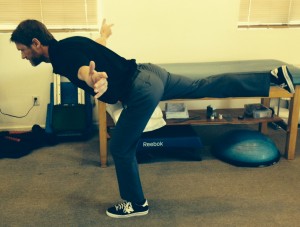| In Part 1 you and I talked about why an efficient golf swing is born from good physical balance. In Part 2 we discussed how I would evaluate your balance and how you can even assess yourself at home. If you did the tests and feel you could use a little help in this department you’re not alone. Balance tests and exercises can be frustrating. They’re supposed to be challenging. If they weren’t they wouldn’t be doing you any good.
In this article, let’s challenge your balance like a golfer. Each exercise I introduce you to now will directly help some part of your golf swing. Wait… please understand if you feel unsafe or painful while doing these exercises, or even feel they could be, they aren’t for you to do until you get help from a professional. I can’t stress that enough. ADDRESS POSITION The address position has been discussed at length for many years. Everyone from golf instructors and medical professionals to biomechanists and broadcasters have chimed in on the subject. I’m sure we can certainly agree it should be comfortable and effective. You’re about to swing a club at a ball and make it go up to a few hundred yards away. Confidence and stability are certainly helpful. Training your body to find stability in an unstable environment off the course is a great way to become stable and confident on the course. Here’s one I often do with my clients specifically for the address position:
The Single Leg Hip Hinge will challenge you in many ways, but by decreasing your base of support it will challenge your ability to balance while bent forward. You have a few things to work on with this one: 1. Stay balanced; 2. Hinge from your hips the best you can with optimal being body parallel to the ground; 3. Stay there (work up to about 10 seconds); 4. Get good on both sides; 5. Barefoot is a good option if wearing shoes is getting too easy. BACKSWING Here’s where it gets serious. You’ve just become “dynamic.” You’re rotating with the intention of “winding up” to hit something. Just the fact you’re moving is making balance more difficult. Once again, let’s make this unstable during your golf training and add a little weight to replicate the momentum that tends to cause problems on the course.
In this exercise your feet are “On a Line”… the front foot is flat with 50% of your weight on the toe and 50% of the weight on your heel (error on the side of more heel). The back foot is on tip-toe with hardly any weight on it. From this position, take a small backswing and return. As you get more comfortable add size to your movement. Rotate right when your right foot is forward. When your left foot is forward rotate left. Another option is to add weight to the movement. Again, start with a small backswing and move to a larger one as tolerated. I’d recommend 8-12 reps each direction, 2-3 sets each way. If moving too quickly causes you to lose your balance, slow it down until you can increase to normal “backswing speed.” DOWNSWING An efficient downswing starts with your lower body. Specifically, your lower body begins to transfer weight and rotate just like any other athlete that strikes or throws. This dynamic change of direction and increase in speed and power brings on all sorts of challenges to your ability to maintain balance. Once again, let’s decrease your base of support while we encourage the lower body to transfer all of your weight to one side and rotate.
This is the Stork Turn exercise Dr. Greg Rose, from the Titleist Performance Institute, taught me many years ago. Just stand on one leg. Hook your foot behind your knee. Rotate your lower body underneath a stable upper body. You might find it difficult to keep your upper body from rotating with your lower body. Try holding both arms out to the side or holding onto a wall or golf club to help you with this part. The secret to the legs is to learn to rotate with the leg that’s on the ground, not the bent knee. FINISH You’re most likely to feel your balance issues at this point of the swing. Either from the swing mechanics before this point going badly, or you’re coming to a complete stop milliseconds after going very fast. Stability is the key here. If you’re being pushed by someone, and you don’t want to fall, your body calls on your stabilizers (muscles). The same thing is happening at the finish… momentum is moving you quickly through the swing and now you’re trying to “stick the landing” in a perfect finish position.
You should do this during your golf fitness workout and I highly recommend it as a warm-up before golf. Do it both directions. Put a little weight in your hands for a workout and do it with a club (as shown) if you’re just warming up. Touch the club to the outside of your calf, knee or thigh depending on your comfort and fitness level (via squat or deadlift) then quickly move into the finish position as shown. It’s at this point you want to “stick the landing” and stay there long enough to go through your “checklist.” 1. Complete control; 2. Fully rotated with your hips and torso; 3. Trail foot up on toe with minimal-zero weight on it. 4. Lead foot fully weighted (go with your instructor’s advice here but our data shows heel is where the better players have their center of gravity at this point). If you need some help with these or you need golf fitness exercises prescribed specifically for you, FitGolf Performance Centers are staffed with experts to help you. Find a FitGolf Performance Center near you. Part IV of the series is coming soon. Until then… All the best.
|







